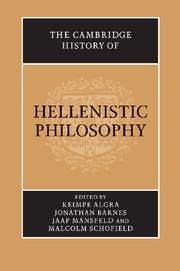Book contents
- Frontmatter
- PART I INTRODUCTION
- PART II LOGIC AND LANGUAGE
- PART III EPISTEMOLOGY
- PART IV PHYSICS AND METAPHYSICS
- 11 Hellenistic physics and metaphysics
- 12 Cosmology
- 13 Theology
- 14 Explanation and causation
- 15 Determinism and indeterminism
- 16 Epicurean psychology
- 17 Stoic psychology
- 18 Philosophy, science and medicine
- PART V ETHICS AND POLITICS
- Synopsis of principal events
- Editions of sources and fragments
- List of abbreviations
- Bibliography
- Index locorum
- General Index
- References
11 - Hellenistic physics and metaphysics
from PART IV - PHYSICS AND METAPHYSICS
Published online by Cambridge University Press: 28 March 2008
- Frontmatter
- PART I INTRODUCTION
- PART II LOGIC AND LANGUAGE
- PART III EPISTEMOLOGY
- PART IV PHYSICS AND METAPHYSICS
- 11 Hellenistic physics and metaphysics
- 12 Cosmology
- 13 Theology
- 14 Explanation and causation
- 15 Determinism and indeterminism
- 16 Epicurean psychology
- 17 Stoic psychology
- 18 Philosophy, science and medicine
- PART V ETHICS AND POLITICS
- Synopsis of principal events
- Editions of sources and fragments
- List of abbreviations
- Bibliography
- Index locorum
- General Index
- References
Summary
Introduction
The Stoics are leading champions of the continuum, the Epicureans its leading opponents. Any such division of Hellenistic schools into continuists and discontinuists provides a useful skeleton, but one which needs careful fleshing out.
The Stoic world – like the Aristotelian world before it – is a continuum both materially and structurally: materially because it contains no void gaps, structurally because it is infinitely divisible, or divisible at any point. The Epicurean world is discontinuous in both ways: materially to the extent that it consists of bodies separated by void gaps, structurally both because those bodies are themselves unbreakable (‘atoms’) and because at a still lower level there is an absolute unit of magnitude not capable of analysis into parts (the ‘minimum’).
In case such a characterization should suggest that the material and structural continua are inseparably united, it is important to appreciate that this was by no means assumed by the contemporaries and immediate forerunners of Epicurus and Zeno. Strato of Lampsacus, head of the Peripatos during the later part of their careers, viewed the world as materially discontinuous, thanks to the existence of minute interstitial pockets of void, but as structurally continuous. If, as seems probable, he gave matter a particulate structure, this was in order to account for change, mixture and the like, and his particles were in no obvious sense indivisible. The same can probably be said of the puzzling theory of ‘dissoluble lumps’ (αναρμοι ογκοι) proposed by the Platonist Heraclides of Pontus in the mid or late fourth century BC.
- Type
- Chapter
- Information
- The Cambridge History of Hellenistic Philosophy , pp. 353 - 411Publisher: Cambridge University PressPrint publication year: 1999
References
- 14
- Cited by

